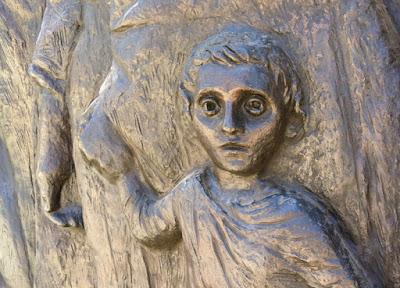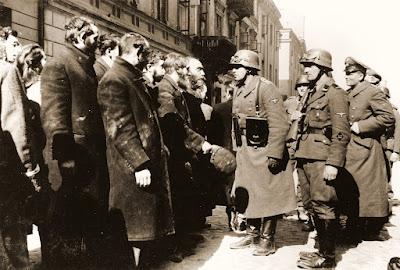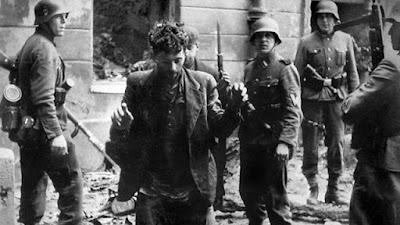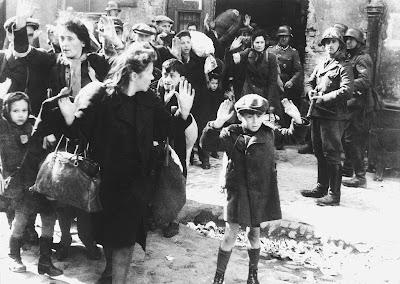 image: Warsaw Ghetto Memorial 1948 (detail)
image: Warsaw Ghetto Memorial 1948 (detail)An earlier post analyzed Wendy Lower's stunningly original treatment of a single photograph of a 1941 mass killing in the town of Miropol, Ukraine (link). The photograph captures the murder of a Ukrainian Jewish mother and her child by German soldiers and Ukrainian militiamen. After extensive investigation Lower was able to determine the identities of the victim, several of the killers, and the photographer. Like many photos documenting the atrocities of the Holocaust, this photograph was taken by a member of the German armed forces, a Slovak named Lubomir Škrovina. Initially Lower takes him to be an accomplice or collaborator, but eventually discovers that he was a dissident and a supporter of the Slovak resistance movement. She finds that Škrovina was concerned to record for the outside world the atrocities he witnessed under German occupation. In fact, Škrovina was a resister, not a collaborator.
Now consider some of the best-known photographs from the Holocaust and their provenance. Some of these images come from the merciless destruction of the Warsaw Ghetto following the Warsaw Ghetto uprising. A largescale aktion was planned by the SS to put down the Warsaw Ghetto uprising in early 1943. The action was conducted by SS-Brigadeführer Jürgen Stroop, and it resulted in the deaths of 13,000 Jewish residents immediately. In the aftermath almost all of the 50,000 survivors were dispatched to the death camps of Majdanek and Treblinka.
We must ask a crucial question: how do we happen to have these photographs? Because the Nazi state was interested in documenting the success of its plans to exterminate the Jews of Poland and all of Europe. These photos were taken by a German military photographer at the orders of Stroop, to record the "efficiency" and completeness of the operation. Triumphal volumes of these photos were subsequently conveyed to Himmler and to the supreme commander of the SS, and eventually the collection of photos made their way into the Nuremberg trials. Originally titled "The Jewish Quarter of Warsaw Is No More!", the collection is now referred to as the "Stroop Report".
Perhaps the most powerful and widely known photograph of the Holocaust comes from the Stroop collection, the "Boy in the Warsaw Ghetto" image (reproduced below). It is an emotionally wrenching image of a group of adults and children with their hands raised being forced out of a Warsaw bunker by German soldiers. In the center of the image is a boy, apparently 8-10 years old, with his hands raised, and a German soldier in the background with a submachine gun aimed in his direction. The tragic inevitability of this group of innocent human beings at the power of ruthless armed men is a powerful emblem of the cruelty and remorselessness of the Holocaust. And what about the Nazi soldier? His identity is now known. His name was SS-Rottenführer Josef Blösche, and he was a notorious genocider who had joined the Nazi Party in 1938. This was no "ordinary man" along the lines of the policemen treated in Christopher Browning's study of Reserve Police Battalion 101 (link). (Blösche appears in several photos in the Stroop collection.) Blösche was convicted of war crimes, including murder of some 2,000 people, and was executed in Leipzig (GDR) in 1969. During his trial he was questioned about the moment captured in this photograph:
Judge: "You were with a submachine gun...against a small boy that you extracted from a building with his hands raised. How did those inhabitants react in those moments?"
Blösche: "They were in tremendous dread."
Judge: "This reflects well in that little boy. What did you think?"
Blösche: "We witnessed scenes like these daily. We could not even think." (Dan Porat, The Boy: A Holocaust Story (Hebrew). Dvir, 2013; quoted in Wikipedia (link))
Here are three especially powerful images from the Stroop file, including the "Boy in the Warsaw Ghetto". Blösche appears in the first and third images, and may also figure in the second image.



These are historically important images of a tragic moment in history. But they raise a difficult question: how should photographs like these be used? They are doubly charged with moral valence: they depict tragic and evil events in which pain and death are imposed on innocent people; they were produced by the perpetrators of that evil history; and they were produced for the purpose of glorifying the "successes" of the Nazi plan of extermination. All of the civilians in these photos are almost certainly doomed -- either immediately in the streets of Warsaw or in the death camps of Majdanek and Treblinka. So how can we treat these photos with the dignity that their human subjects deserve, while at the same time allowing the viewer to learn important aspects of the history of the Shoah that urgently need to be understood? (Recall the profound insights Wendy Lower reached in her analysis of an equally powerful and tragic image.)
Perhaps the question answers itself: treat images like these with the respect and dignity that the subjects deserve; and do so solely for purposes that lead to greater understanding of these terrible events -- not for entertainment, not for extraneous "marketing" purposes. For example, the World Wrestling Entertainment corporation recently used footage from Auschwitz to advertise an upcoming match. The Auschwitz-Birkenau Memorial and Museum released a compelling statement: “Exploiting the site that became a symbol of enormous human tragedy is shameless and insults the memory of all victims of Auschwitz”. WWE subsequently apologized (link).
We could say the same about careless and unthinking uses of these black-and-white photographs for purposes other than respectful understanding and remembrance.
(A full file of the Stroop Report photos is available here. Here are brief historical accounts of the Warsaw Ghetto uprising (link, link) and a video exhibition recording survivors' experiences from Yad Vashem (link).)
